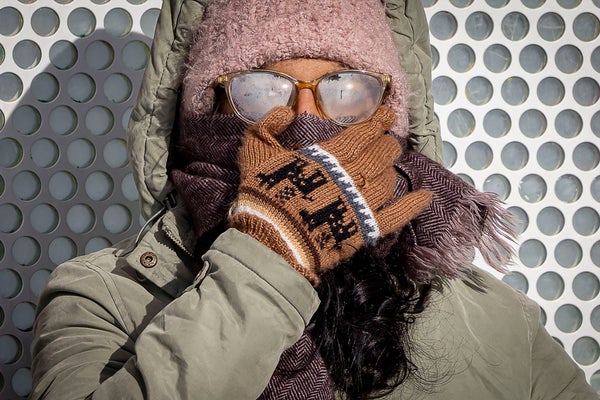A cold snap recently gripped the U.S., plunging many states into temperatures far below what is typical for an average winter. In Nashville, Tenn., readings plummeted to minus one degree Fahrenheit (–18 degrees Celsius), while Oregon declared a state of emergency as a severe ice storm caused lows in the teens and an uptick in weather-related deaths. In famously balmy Florida, thermometers dipped as low as 20 degrees F (–6.7 degrees C)—chilly enough to see cold-stunned iguanas falling from the trees and residents complaining on social media about the deep freeze. But rather than finding sympathy, people in the Sunshine State faced a barrage of jokes from across the Internet; what feels unbearably cold to Floridians may be nothing to, say, people from Minnesota.
Temperature may be an objective measurement, but our experience of it is not. Some surprising factors, including psychological and social ones, influence how we perceive temperature and why some places feel hotter or colder than others—even when the temperature outside is identical.
Humidity and wind chill are among the two most important factors that “can make an otherwise neutral temperature feel much hotter or colder than it is,” says Marshall Shepherd, an atmospheric scientist at the University of Georgia. If it’s 70 degrees F (21 degrees C) but very humid, for example, the air can become so saturated that our sweat no longer evaporates, leaving us feeling more uncomfortably warm than if the air were dry. Hot air tends to contain more water molecules than cooler air, making this effect feel more extreme when temperatures soar, but it’s still possible to saturate cooler air—and enough moisture creates dew or frost. On cold, humid days, it’s important not to let that moisture come in contact with your skin, because body heat will be pulled out to warm the cold water. Wind can similarly snatch away our body’s warmth, making the air feel several degrees cooler. The recent wind chill in Florida, for instance, made it feel like it was 10 degrees F (5.6 degrees C) colder than the actual temperature in some places. “A breeze is therefore a blessing on a hot day but potentially deadly on a cold one,” Shepherd says.
On supporting science journalism
If you're enjoying this article, consider supporting our award-winning journalism by subscribing. By purchasing a subscription you are helping to ensure the future of impactful stories about the discoveries and ideas shaping our world today.
But assessing how weather really feels gets more complicated when experts consider more than 100 additional metrics for studying temperature’s effects on people. Researchers are increasingly moving away from measurements that include just a few variables, such as the heat index (which is calculated using just relative humidity and temperature), toward ones that incorporate complex meteorological data into human physiology and behavior models.
Our physiological responses and the way we modify our behavior to deal with temperature are also significant factors and are dictated by our geography, psychology and even culture. Europeans and Americans have different ideas of what constitutes a “comfortable” temperature, for example, because they’re physiologically adapted to specific climates, and this extends into how people live their daily life. Americans are far more likely to use air conditioning than their European counterparts, leading some Americans to perceive buildings in other countries as hot and stuffy when traveling. Research has also shown that Inuit living in Greenland have genes that modify fat type and distribution to better insulate their core, while people living in Indonesia are able to increase blood flow to their skin to facilitate cooling. People from either group might initially be miserable if they traded locations, though it is possible to evolve or otherwise adapt to a new climate over time.
Our previous experiences similarly affect how hot or cold we feel, says María Sánchez-Vives, a neuroscientist at the August Pi i Sunyer Biomedical Research Institute in Spain. Using virtual reality, Sánchez-Vives and her colleagues showed that when a person’s virtual arm was colored red—a color our brain associates with inflammation—they became more sensitive to heat. “Our perception does not only depend on the stimulus that is being provided but on the information that is already stored in our brain,” she says.
A similar mechanism may underlie so-called cold contagion, or people’s tendency to sync their physiological or behavioral responses to perceived temperatures. In a 2014 study, participants watched videos of people immersing their hand in visibly cold water—and it actually made their own hands measurably cooler. These results suggest that, at least for cold temperatures, our body picks up on and responds to social cues.
Our clothing choices also matter, particularly on cold days. Trisha Andrew, a materials scientist at the University of Massachusetts Amherst, says that people often opt for clothing made of synthetic fabrics such as fleece because they think that garments made of these materials will perform better than those made of natural fibers. But even though synthetics are great at wicking away moisture, that’s not always a good thing. Shuttling moisture away from your skin becomes important for staying cool during high-energy, sweaty activities, so synthetic fabrics aren’t the best choice when the weather is cold. Andrew says that to stay warm, she opts for natural textiles such as wool or silk that are better at trapping heat.
“Unlike synthetics, which are mostly plastics, natural materials actually absorb a small amount of moisture, drying out the air in between layers so that you have less of a conductive channel to radiate heat away from your body,” she says. When traveling to an unfamiliar place with a different climate, experts say that looking to locals can be helpful in deciding how best to dress for the weather. And don’t assume your body will immediately know how to respond—it takes time to adjust to new conditions.
